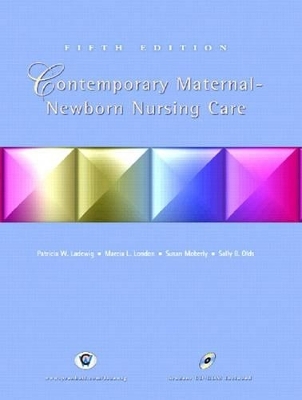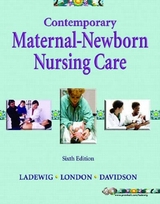
Contemporary Maternal-Newborn Nursing Care
Pearson Education (US)
978-0-8053-8051-4 (ISBN)
- Titel erscheint in neuer Auflage
- Artikel merken
Appropriate as a core text as well as a reference for a maternity nursing course.
Nurses working with childbearing families today face a variety of new challenges, including shortened lengths of stay, the trend toward greater use of community-based and home care, downsizing and mergers of health care systems. The Fifth Edition, formerly titled Maternal-Newborn Nursing Care: The Nurse, the Family, and the Community, continues to emphasize the central role played by nurses working with today's childbearing families.
Preface.
Reviewers.
About the Authors.
I. BASIC CONCEPTS.
1. Contemporary-Maternal Newborn Care.
Nursing Roles. Contemporary Childbirth. Legal Considerations. Ethical Issues. Evidence-Based Practice in Maternal-Newborn Nursing. Implications for Nursing Practice.
2. Reproductive Anatomy and Physiology.
Female Reproductive System. The Female Reproductive Cycle. Male Reproductive System.
3. Conception and Fetal Development.
Cellular Division. The Process of Fertilization. Preembryonic Development. Development and Functions of the Placenta. Embryonic and Fetal Development.
II. WOMEN: THE REPRODUCTIVE YEARS.
4. Women's Health Care.
Menstruation. Contraception. Recommended Gynecologic Screening Procedures. Menopause. Assisting with a Pelvic Examination. Violence against Women. Care of the Woman with a Benign Disorder of the Breast. Care of the Woman with Endometriosis. Care of the Woman with Toxic Shock Syndrome. Care of the Woman with a Sexually Transmitted Infection. Care of the Woman with Pelvic Inflammatory Disease. Care of the Woman with an Abnormal Finding during Pelvic Examination. Care of the Woman with a Urinary Tract Infection. Pelvic Relaxation.
5. Families with Special Reproductive Concerns.
Infertility. Genetic Disorders.
6. Preparation for Parenthood.
Preconception Counseling. Childbearing Decisions. Classes for Family Members during Pregnancy. Education of the Family Having Cesarean Birth. Preparation for Parents Desiring Vaginal Birth after Cesarean Birth (VBAC). Childbirth Preparation Methods. Preparation for Childbirth That Supports Individuality.
III. PREGNANCY AND THE FAMILY.
7. Physiological and Psychological Changes of Pregnancy.
Anatomy and Physiology of Pregnancy. Signs of Pregnancy. Psychologic Response of the Expectant Family to Pregnancy. Cultural Values and Reproductive Behavior.
8. Antepartal Nursing Assessment.
Initial Client History. Initial Prenatal Assessment. ASSESSMENT GUIDE: Initial Prenatal Assessment. Subsequent Client History. ASSESSMENT GUIDE: Subsequent Prenatal Assessment. Subsequent Prenatal Assessment.
9. The Expectant Family: Needs and Care.
Nursing Care Management. Care of the Expectant Father and Siblings. Relief of the Common Discomforts of Pregnancy. Promotion of Self-Care during Pregnancy. Evaluation. Care of the Expectant Couple over Age 35.
10. Adolescent Pregnancy.
Overview of the Adolescent Period. Factors Contributing to Adolescent Pregnancy. Risks to the Adolescent Mother. Partners of Adolescent Mothers. Reactions of Family and Social Network to Adolescent Pregnancy. Prevention of Adolescent Pregnancy.
11. Maternal Nutrition.
Maternal Weight Gain. Nutritional Requirements. Vegetarianism. Factors Influencing Nutrition. Nutritional Care of the Pregnant Adolescent. Postpartum Nutrition.
12. Pregnancy at Risk: Pregestational Problems.
Care of the Woman with Substance Abuse Problems. Care of the Woman with Diabetes Mellitus. CRITICAL PATHWAY: For the Woman with Diabetes Mellitus. Care of the Woman with Anemia. Care of the Woman with HIV Infection. CRITICAL PATHWAY: For a Woman with HIV/AIDS. Care of the Woman with Heart Disease. Other Medical Conditions and Pregnancy.
13. Pregnancy at Risk: Gestational Onset.
Care of the Woman with a Bleeding Disorder. Care of the Woman with an Ectopic Pregnancy. Care of the Woman with Gestational Trophoblastic Disease. Care of the Woman with an Incompetent Cervix. Care of the Woman with Hyperemesis Gravidarum. Care of the Woman with Premature Rupture of Membranes. DRUG GUIDE: Magnesium Sulfate. Care of the Woman with a Hypertensive Disorder. CRITICAL PATHWAY: For a Woman with Pregnancy-Induced Hypertension. PROCEDURE 13-1: Assessing Deep Tendon Reflexes and Clonus. Care of the Woman at Risk for Rh Sensitization. PROCEDURE 13-2: Administration of Rh Immune Globulin. Care of the Woman at Risk Due to ABO Incompatibility. Care of the Woman Requiring Surgery during Pregnancy. Care of the Woman Suffering Trauma from an Accident. Care of the Battered Pregnant Woman. Care of the Woman with a TORCH Infection. Other Infections in Pregnancy.
14. Assessment of Fetal Well-Being.
Maternal Assessment of Fetal Activity. Ultrasound. Doppler Blood Flow Studies (Umbilical Velocimetry). Nonstress Test. Fetal Acoustic Stimulation Test (FAST) and Vibroacoustic Stimulation Test (VST). Biophysical Profile. Contraction Stress Test. Amniotic Fluid Analysis. PROCEDURE 14-1: Assisting during Amniocentesis. Other Fetal Diagnostic Testing.
IV. BIRTH AND THE FAMILY.
15. Processes and Stages of Labor and Birth.
Critical Factors in Labor. The Physiology of Labor. Stages of Labor and Birth. Maternal Systemic Response to Labor. Fetal Response to Labor.
16. Intrapartal Nursing Assessment.
Maternal Assessment. ASSESSMENT GUIDE: Intratpartal—First Stage of Labor. PROCEDURE 16-1: Performing an Intrapartal Vaginal Examination. Fetal Assessment. PROCEDURE 16-2: Auscultation of Fetal Heart Rate. PROCEDURE 16-3: Electronic Fetal Monitoring.
17. The Family in Childbirth: Needs and Care.
Nursing Diagnosis during Labor and Birth. Nursing Care Management during Admission. CRITICAL PATHWAY: For Intrapartal Stages. Nursing Care Management during the First Stage of Labor. Nursing Care Management during the Second Stage of Labor. Nursing Care Management during the Third and Fourth Stages of Labor. PROCEDURE 17-1: Performing Nasal Pharyngeal Suctioning. PROCEDURE 17-2: Evaluating Lochia after Birth. Nursing Care Management during Nurse-Attended Birth. Evaluation.
18. Maternal Analgesia and Anesthesia.
Systemic Drugs. Regional Anesthesia and Analgesia. CRITICAL PATHWAY: For Epidural Anesthesia. DRUG GUIDE: Postbirth Epidural Morphine. General Anesthesia.
19. Childbirth at Risk.
Care of the Woman at Risk Due to Anxiety and Fear. Care of the Woman with Dystocia Related to Dysfunctional Uterine Contractions. Care of the Woman with Postterm Pregnancy. Care of the Woman and Fetus at Risk Due to Fetal Malposition. Care of the Woman and Fetus at Risk Due to Fetal Malpresentation. Care of the Woman and Fetus at Risk Due to Macrosomia. Care of the Woman with Multiple Gestation. Care of the Woman and Fetus in the Presence of Fetal Distress. Care of the Family at Risk Due to Intrauterine Fetal Death. Care of the Woman and Fetus at Risk Due to Placental Problems. Care of the Woman and Fetus with a Prolapsed Umbilical Cord. Care of the Woman and Fetus at Risk Due to Amniotic Fluid-Related Complications. CRITICAL PATHWAY: For Hemorrhage in Third Trimester and at Birth. Care of the Woman with Cephalopelvic Disproportion (CPD). Care of the Woman at Risk Due to Complications of the Third and Fourth Stages of Labor.
20. Birth-Related Procedures.
Care of the Woman during Version. Care of the Woman during Amniotomy. Care of the Woman during Cervical Ripening. DRUG GUIDE: Dinoprostone (Cervidil) Vaginal Insert. Care of the Woman during Labor Induction. Care of the Woman during Amnioinfusion. DRUG GUIDE: Oxytocin (Pitocin). CRITICAL PATHWAY: For Induction of Labor. Care of the Woman during an Episiotomy. Care of the Woman during Forceps-Assisted Birth. Care of the Woman during Vacuum-Assisted Birth. Care of the Family during Cesarean Birth. Care of the Woman Undergoing Vaginal Birth after Cesarean (VBAC).
V. THE NEWBORN.
21. The Physiologic Responses of the Newborn to Birth.
Respiratory Adaptations. Cardiovascular Adaptations. Hematopoietic System. Temperature Regulation. Hepatic Adaptations. Gastrointestinal Adaptations. Urinary Adaptations. Immunologic Adaptations. Neurologic and Sensory-Perceptual Functioning.
22. Nursing Assessment of the Newborn.
Timing of Newborn Assessments. Estimation of Gestational Age. Physical Assessment.
23. Normal Newborn: Needs and Care.
Nursing Care Management during Admission and the First 4 Hours of Life. CRITICAL PATHWAY: For Newborn Care. PROCEDURE 23-1: Thermoregulation of the Newborn. DRUG GUIDE: Vitamin KI Phytonadione (Aquamephton). DRUG GUIDE: Erythromycin Ophthalmic Ointment (Ilotycin Ophthalmic). Nursing Care Management for Newborn Care during Stay in Birthing Unit. Evaluation.
24. Newborn Nutrition.
Nutritional Needs of the Newborn. Newborn Feeding. Community-Based Nursing Care. Nutritional Assessment of the Infant.
25. The Newborn at Risk: Conditions Present at Birth.
Identification of At-Risk Newborns. Care of the Small-for-Gestational-Age (SGA) Newborn. Care of the Large-for-Gestational-Age (LGA) Newborn. CRITICAL PATHWAY: For Small for-Gestational Age Newborns. Care of the Infant of a Diabetic Mother (IDM). Care of the Postterm Newborn. Care of the Preterm (Premature) Newborn. PROCEDURE 25-1: Performing Gavage Feeding. Care of the Newborn of a Substance-Abusing Mother. CRITICAL PATHWAY: For Newborn of a Substance Abusing Mother. Care of the Newborn at Risk for HIV/AIDS. Care of the Newborn with Congenital Anomalies. Care of the Newborn with Congenital Heart Defect. Congenital Anomalies: Identification and Care in Newborn Period. Care of the Newborns with Inborn Errors of Metabolism.
26. The Newborn at Risk: Birth-Related Stressors.
Care of the Newborn at Risk Due to Asphyxia. DRUG GUIDE: Naloxone Hydrochloride (Narcan). Care of the Newborn with Respiratory Distress. CRITICAL PATHWAY: Care of a Newborn with Respiratory Distress. Care of the Newborn with Meconium Aspiration Syndrome. Care of the Newborn with Cold Stress. Care of the Newborn with Hypoglycemia. PROCEDURE 26-1: Performing a Heel Stick on a Newborn. Care of the Newborn with Jaundice. CRITICAL PATHWAY: For Care of a Newborn with Hyperbilirubinemia. Care of the Newborn with Anemia. Care of the Newborn with Polycythemia. Care of the Newborn with Infection. Care of Family with Birth of an At-Risk Newborn.
VI. POSTPARTUM.
27. Postpartal Adaptation and Nursing Assessment.
Postpartal Physical Adaptations. Postpartal Psychologic Adaptations. Postpartal Nursing Assessment. ASSESSMENT GUIDE: Postpartal—First 24 Hours After Birth. PROCEDURE 27-1: Assessing the Fundus Following Vaginal Birth. Assessment of Physical and Developmental Tasks.
28. The Postpartal Family: Needs and Care.
Nursing Care Management during the Early Postpartal Period. CRITICAL PATHWAY: For the Postpartal Period. DRUG GUIDE: Methylergonovine Maleate (Methergine). Nursing Care Management after Cesarean Birth. DRUG GUIDE: Postpartum Epidural Morphine. Nursing Care Management for the Postpartal Adolescent. Nursing Care Management for the Woman Who Is Relinquishing Her Baby. Discharge Information.
29. Home Care of the Postpartal Family.
Considerations for the Home Visit. Home Care: The Newborn. Home Care: The Mother and Family. ASSESSMENT GUIDE: Postpartal—First Home Visit and Anticipated Progress at 6 Weeks.
30. The Postpartal Family at Risk.
Nursing Care Management of the Postpartal Family at Risk. Care of the Woman with Postpartal Hemorrhage. Care of the Woman with a Reproductive Tract Infection or Wound. CRITICAL PATHWAY: For the Woman with a Puerperal Infection. Care of the Woman with a Urinary-Tract Infection. Care of the Woman with Mastitis. Care of the Woman with Postpartal Thromboembolic Disease. CRITICAL PATHWAY: For the Woman with Thromboembolic Disease. Care of the Woman with a Postpartum Psychiatric Disorder.
APPENDICES.
A. Common Abbreviations in Maternal-Newborn and Women's Health Nursing.
B. Conversions and Equivalents.
C. The Pregnant Patient's Bill of Rights.
D. Clinical Estimation of Gestational Age.
E. Sign Language for Health Care Professionals.
F. Clinical Estimation of Gestational Age.
G. Actions and Effects of Selected Drugs during Breastfeeding.
H. Selected Maternal-Newborn Laboratory Values.
I. Suggested Answers to Critical Thinking in Practice Questions.
Glossary.
Art and Photography Credits.
Index.
| Erscheint lt. Verlag | 16.8.2001 |
|---|---|
| Verlagsort | Upper Saddle River |
| Sprache | englisch |
| Gewicht | 2156 g |
| Themenwelt | Medizin / Pharmazie ► Medizinische Fachgebiete ► Gynäkologie / Geburtshilfe |
| Medizin / Pharmazie ► Pflege | |
| ISBN-10 | 0-8053-8051-5 / 0805380515 |
| ISBN-13 | 978-0-8053-8051-4 / 9780805380514 |
| Zustand | Neuware |
| Haben Sie eine Frage zum Produkt? |
